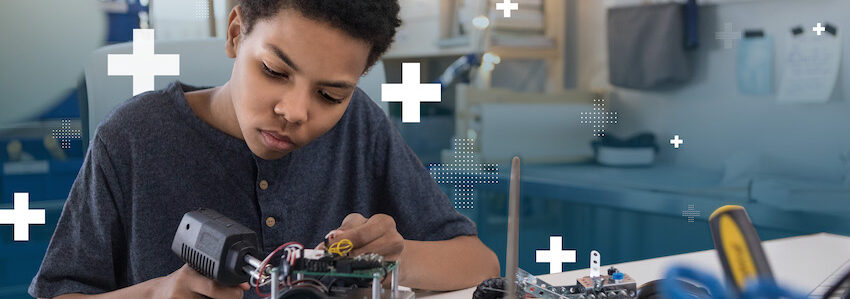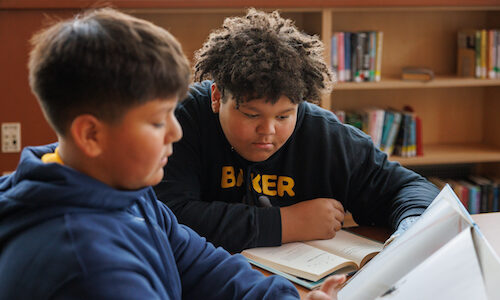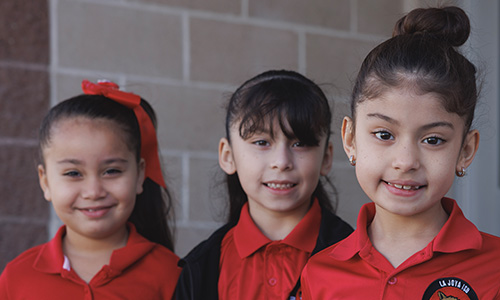
My son had a teacher in third grade who changed everything for him. Up to that point, recess was his favorite subject. Then he was introduced to inquiry-based learning that extended beyond the classroom. And, suddenly, really important things (other than recess) were happening at school.
We live in Portland, Oregon, and you may already know about our city’s struggle with a growing homeless population. What you probably don’t know is that my son’s = class set out to answer this essential question: What can we do to help the homeless people in our community? And they did so with some impressive results. They researched homelessness and wrote about it, made bread and delivered it to a local homeless shelter, and then interviewed some of the people they met there. They used this data to design and build a mobile shelter, which they donated to one of the interviewees. (To learn more about this experience in the students’ own words, read “Kids point the way: Beaverton third graders offer a new perspective, practical answers on homelessness.” It’s the second article on the website I link to.)
The key takeaway from this example is that inquiry-based learning can ignite the learner in all of us. And when teachers, caregivers, and communities get involved—as they did with this third-grade classroom—that’s when the real learning happens. So, how did it all start? By crafting the right essential question.
What is an “essential” question?
An essential question sounds important, and it is. An essential question does three important things:
1. An essential question addresses a topic relevant to real people in the real world
Kids are great at knowing when a problem is real or contrived, and academic tasks in some curricula are often the latter. Authenticity can’t be faked.
Talk to your students about issues that matter to them, in their community or beyond. That can help you explore questions more likely to pique their curiosity.
2. An essential question has many possible answers
The goal of an essential question is for students to explore universal concepts that help them arrive at new understandings of the world they live in.
Here is what my son’s third-grade classmates had to say about homelessness in the article published in our local paper: “There are lots of reasons people end up homeless.” “To afford a house here, you have to make $31 an hour.” “When you have a minimum-wage job and the price of things goes up, there is a chance you will end up homeless.”
I am struck by the students’ understanding of complex concepts like interdependence, economy, and stability. There was no “right answer” to this essential question, only endless possibilities.
3. An essential question is worthy of study and discussion
A good essential question is one that encourages ongoing inquiry. Since there is no definitive right answer, students can’t just ask ChatGPT.
The way students might answer the question today is likely different from how they would answer it in the future. This could be because of a changed perspective, new technology, or many other reasons.
Finally, a good essential question allows students to research a topic through different lenses and apply what they learn to different disciplines. The students in my son’s third-grade class engaged in real-world math (housing costs, wage earnings), writing (a research paper, a product ad), and STEM (design, engineering). This interdisciplinary study gave them multiple entry points into the topic and multiple ways to demonstrate their learning. They worked in small groups of about five, and each group discussed, imagined, and created a prototype of the mobile shelter. Then the class voted on the best design and built it (with some help), just as adults would in the real world.
Why are essential questions better than other types of questions?
An essential question hooked my son on learning because it addressed work that mattered, and he knew it and wanted to be a part of it. Engaging students in work that matters is difficult but important.
In Authentic Instruction and Assessment, this kind of learning is called authentic intellectual work, and it has three primary components.
- Construction of knowledge. Students have an opportunity to organize, interpret, evaluate, or synthesize prior knowledge to solve new problems that are both rigorous and personally meaningful. The work must be an original application of knowledge and skills, not a routine use of facts and procedures.
- Disciplined inquiry. Students are able to strive for in-depth understanding of a topic and they develop and express their ideas through extended written, oral, and/or digital communication. The work must involve students in a careful, detailed study of a particular problem.
- Value beyond school. Students find intellectual challenges that come from the real world to be more meaningful than those contrived for the sole purpose of teaching or assessment. Authentic intellectual work must mimic work done by adults in the real world with students taking on the role of apprentice to a profession or discipline.
In Authentic Instruction and Assessment, the most compelling finding from the authors’ 13 years of research is that authentic intellectual work benefits all students. In fact, it benefits higher-performing students only slightly more than other students. The authors also found that authentic intellectual work can reduce the link between students’ academic achievement and socioeconomic status. It did not eliminate this gap completely, but it did decrease it.
The authors also discovered that students with disabilities benefit substantially from authentic intellectual work, in part because this work creates learning environments that are better suited for students with learning differences. Authentic intellectual work often lets students play to their strengths and use different modes to show what they know and can do. This has certainly been true for my son, who has ADHD. While he struggled with writing the research paper on homelessness, doing the hands-on work of designing and building the prototype for a mobile shelter gave him a place to shine.
How do I write a good essential question?
Here are five tips for using effective essential questions with your students:
1. Make it conceptual
Essential questions are not content-specific questions. They are broad concepts that can apply to many content areas.
Identify one or more concepts for your students to explore, such as behavior, environment, or choice. The book Differentiation in Middle and High School: Strategies to Engage All Learners provides a good list (on page 36). Many of these concepts are appropriate for elementary school, too, such as the concept of community explored in my son’s third-grade project, and more advanced concepts can be adapted for younger students.
Using a concept to frame an essential question promotes connected learning rather than isolated skills or facts. For example, students might explore history as a cycle, meaning it is both tethered to the past and connected to the future. The concept of a cycle helps students think more critically about history and make connections beyond those provided in a textbook. Such relational understanding has many benefits. According to neurologist and educator Judy Willis, “Whenever new material is presented in such a way that students see relationships, they generate greater brain cell activity and achieve more successful long-term memory storage and retrieval.”
2. Make it debatable
Students should be able to approach and answer an essential question from many different angles. Avoid one-sided issues, like recycling, and polarizing issues, like politics. Instead, focus on multi-sided issues that prompt healthy debate.
The sweet spot is a topic that allows students to share their opinions and experiences and also do research to deepen their understanding and uncover new perspectives. Students might explore the impacts of water pollution on their local water sources, for instance, and then use this knowledge to consider the intersection between science and policy.
3. Make it student friendly
Consider what topics are interesting, relevant, and worthy of study for your students. Then write the essential question in student-friendly language.
For younger students, the questions might look something like this:
- What can humans learn from animals? (Concept: behavior)
- How does where I live affect how I live? (Concept: environment)
- How do we know how to make good decisions? (Concept: choice)
For older students, the broad concept can be embedded in the question:
- How does human imagination help improve people’s lives?
- How can society balance the needs of people with the needs of nature?
- How does language affect the way people think about the world?
For more examples of good essential questions, explore the free design tool developed by the authors of Understanding by Design.
4. Make it meaningful
Provide students with a meaningful context for the essential question. Imagine a scenario that will spark your students’ interest and use it in a launch lesson. During the project, show students how they can apply academic skills to help them answer the bigger question.
For example, my son’s third-grade class had to use math skills to arrive at a deeper understanding of homelessness:
- How much money must a person make to pay rent or buy a house in this area?
- How can I convert this total dollar amount into an hourly wage?
- What is the difference between this hourly wage and the minimum wage in my area?
While my son was not very interested in doing complex word problems like this from his math textbook, he was interested in learning more about homelessness and what he could do about it.
5. Make it student driven
Give students meaningful opportunities for choice and voice. This kind of differentiated instruction encourages learners to direct their own learning and teachers to facilitate the learning process as a “guide on the side.”
Giving students some autonomy over an academic task increases their engagement and persistence, and it leads to better achievement outcomes, too.
Fast forward to today
My son is now in his senior year of high school and wants to be an engineer. Knowing that he has already helped create a practical solution for a seemingly intractable problem like homelessness gives me hope for him and his entire generation.
If my son’s third-grade class could gather input from people who are homeless and use that information to design and build a mobile shelter, it seems there’s no problem too big or too complex for them to tackle in the future. We can help prepare all students for this real-world work by infusing more inquiry-based learning into their K–12 education. Let’s start now. We’re going to need every one of their bright minds and creative solutions for the work ahead.







